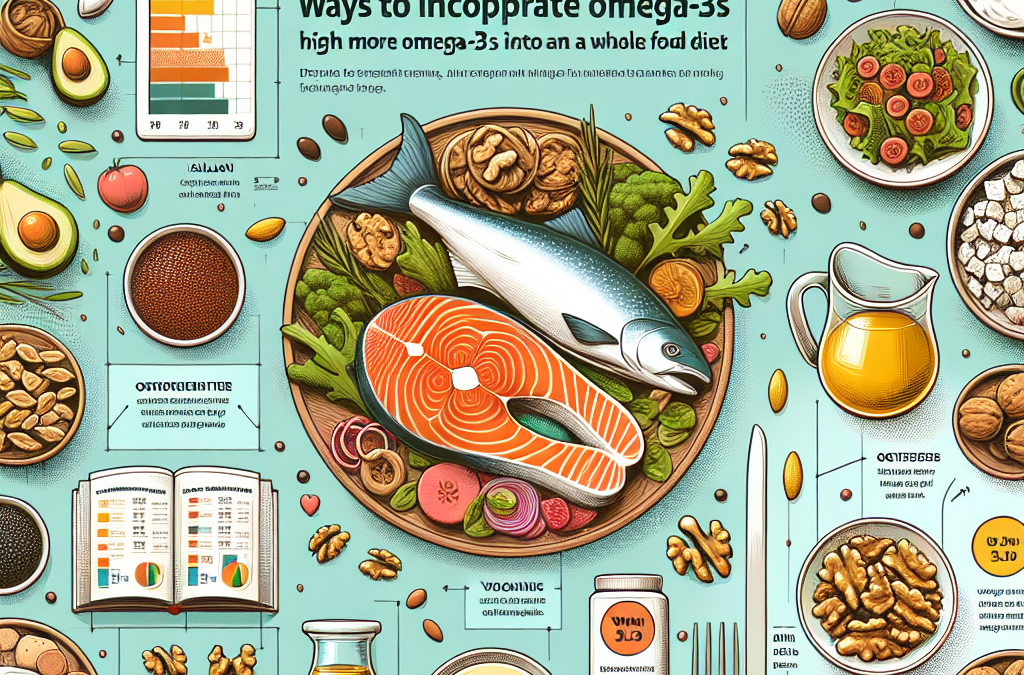Understanding Omega-3 Fatty Acids
What are Omega-3 Fatty Acids?
First off, let’s talk about what omega-3 fatty acids actually are. These bad boys are essential fats that your body can’t make on its own, which means we have to get them from our diets. They play a crucial role in brain function, as well as normal growth and development. Seriously, they’re vital!
Omega-3s are primarily found in certain foods, and they come in various forms, including ALA (alpha-linolenic acid), EPA (eicosapentaenoic acid), and DHA (docosahexaenoic acid). While ALA is generally obtained from plant sources, EPA and DHA are mostly found in marine sources like fish and algae. Knowing this is half the battle!
Incorporating omega-3s into your diet can lead to numerous health benefits, including reduced inflammation, improved heart health, and potential brain health perks. So, it’s not just a trend; it’s about upping your wellness game.
Sources of Omega-3 in Whole Foods
Fatty Fish
Now, when I think of omega-3-rich foods, fatty fish jump to the forefront. Foods like salmon, mackerel, and sardines are not only delicious but also power-packed with EPA and DHA. I mean, who doesn’t enjoy a beautifully grilled salmon fillet?
It’s important to opt for sustainably sourced fish to keep our oceans healthy. I like to check labels or ask at my local market to ensure I’m making the right choice. One of my go-to recipes is baked salmon with herbs; easy peasy and oh-so-yummy!
If you aren’t a fan of fish, don’t fret! There are plenty of other options, and I’ll get into those shortly. But remember, including fish in your weekly meal plan is a solid step toward boosting your omega-3 intake.
Nuts and Seeds
Oh, I can’t get enough of nuts and seeds! Flaxseeds, chia seeds, and walnuts are fantastic plant-based sources of ALA. I’ll throw some chia seeds into my morning smoothie or whip up a quick and crunchy trail mix with walnuts.
Flaxseeds can be a tad tricky since our bodies don’t digest them as easily whole, so I usually grind them up before adding them to my meals. They give a nutty taste and can be super versatile! You can mix them into baking recipes or sprinkle them on salads.
These options are not just tasty but super healthy too! They’re packed with fiber, antioxidants, and additional nutrients, making them an excellent addition to your whole foods diet.
Plant-Based Oils
Let’s not forget about the oils! Certain oils are rich in omega-3s; I swear by flaxseed oil for salad dressings. It adds a delightful nutty flavor while packing in those healthy fats.
You can also experiment with canola oil or walnut oil. I love sautéing my veggies in a mix of olive oil and walnut oil; it adds a rich flavor while maximizing those omega-3 benefits. Plus, it’s an easy swap that doesn’t sacrifice taste!
Drizzle these oils on your meals for a nutritious kick or mix them into your dips and spreads. You’ll be surprised how a little bit can go a long way in enhancing both flavor and health!
Incorporating Omega-3s into Your Meals
Planning Your Weekly Menu
Planning is key, folks! I’m all about making a weekly menu where I include sources of omega-3 in each meal. It helps to keep me accountable and ensures I’m getting those health benefits.
For instance, I schedule baked salmon on Mondays, a salad with chia seed dressing on Tuesdays, and wonderous walnut pesto pasta on Wednesdays. By mapping it out, I make sure I include a variety of sources—it’s like a fun little scavenger hunt but for good health!
Don’t forget to include side dishes that complement the main event. For example, a side of sautéed spinach cooked in a little flaxseed oil can really elevate your omega-3 game.
Experimenting with Recipes
Get creative in the kitchen! I love finding new recipes that showcase omega-3 ingredients. Whether it’s experimenting with smoothies, dips, or full meals, there’s a world of possibilities.
If you’re adventurous, why not try making your own energy bars with flaxseeds and almonds? They’re a great snack and can satisfy your sweet tooth! I often customize them with my favorite nuts and fruits.
Another idea is flavoring your oatmeal or yogurt with a spoonful of chia or flaxseed. It’s a simple yet effective way to give your breakfast a nutritional boost. Trust me, your taste buds—and your body—will thank you!
Get an Amazing Discount on the Best Certified Organic Whole Food Supplement!
Staying Consistent
Let’s keep it real: consistency is crucial. I aim to include omega-3-rich foods in my daily meals rather than just occasionally. This doesn’t have to be burdensome; think of it as a fun challenge!
Creating a little chart or a list of omega-3 foods I love can motivate me to mix it up daily. The more familiar I become with these foods, the easier it is to incorporate them. Plus, the benefits keep me coming back for more!
Keep a food diary if you need to hold yourself accountable. It can be pretty rewarding to look back and see just how you’ve enriched your diet over time.
Supplements: A Backup Plan
When to Consider Supplements
Sometimes, life gets busy, and even the best-laid plans can fall short. If you feel you’re not getting enough omega-3s from food alone, supplements can be a good backup plan. I personally prefer to prioritize food first, but I keep some fish oil capsules handy for those hectic weeks!
It’s super important to do your homework on the supplements you’re considering. Look for reputable brands that get their omega-3s from sustainable sources, as quality matters significantly. It can make a big difference in how your body absorbs the nutrients!
If you have specific health concerns or dietary restrictions, chatting with a healthcare professional could provide tailored advice. They can help you figure out if supplements are right for you and how much you might need.
Types of Omega-3 Supplements
There are several types of omega-3 supplements out there: fish oil, krill oil, and algae oil, to name a few. I’ve tried a couple of them, and they each have unique benefits. Fish oil is generally the go-to for most people, but if you’re plant-based, algae oil is a fantastic option.
Krill oil is richer in antioxidants compared to regular fish oil, and some folks swear by it. It’s all about finding what works best for your lifestyle and needs. A little research can go a long way in this process!
Clearly, you have choices, and with the right information, you can navigate the supplement aisle like a pro.
Finding Balance
While supplements can offer a safety net, I always remind myself to keep my focus on whole foods. It’s all about finding that balance between what’s fresh, what’s convenient, and what’s beneficial for my health.
I try to think of supplements as a complementary addition rather than a replacement for a healthy diet. The real magic happens when I focus on nutrient-rich foods and use supplements to fill in the gaps.
The best approach is to consider supplements as part of a holistic strategy toward better health—focusing on overall wellness and not just one specific nutrient.
Frequently Asked Questions
1. What are the main benefits of omega-3 fatty acids?
Omega-3 fatty acids are known for their anti-inflammatory properties, promoting heart health, supporting brain function, and potentially improving mood and mental health. They play an essential role in overall well-being.
2. How often should I consume omega-3s?
For adults, the recommendation is at least two servings of fatty fish per week. However, if you’re relying on plant sources or supplements, aim for a consistent intake daily, adjusting as needed based on dietary preferences or health goals.
3. Can I get enough omega-3s without eating fish?
Absolutely! There are plenty of plant-based sources like flaxseeds, chia seeds, walnuts, and certain oils. Algae oil supplements are also a great option for those avoiding fish.
4. Are there any risks in taking omega-3 supplements?
While omega-3s are generally safe, it’s essential to consult with a healthcare provider before starting supplements, especially if you have existing health conditions or are on medication, to avoid any potential interactions.
5. How can I ensure I’m getting enough omega-3s?
By planning your meals to include omega-3 sources regularly, experimenting with new recipes, and possibly considering supplements if needed, you can make sure you’re meeting your omega-3 needs while enjoying delicious food!




